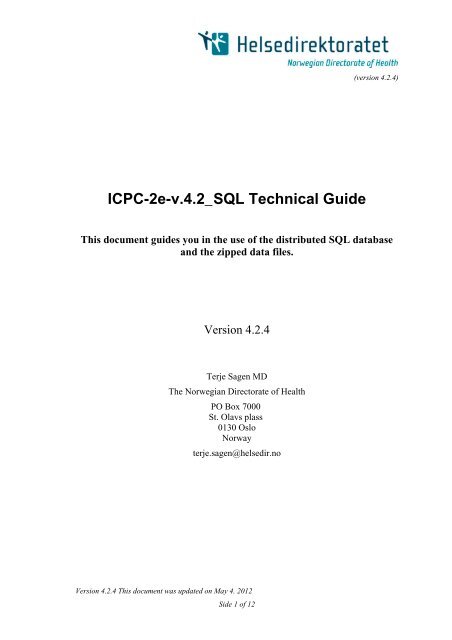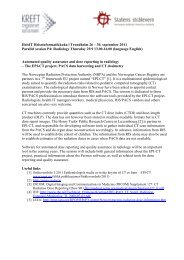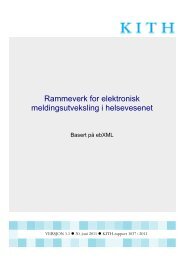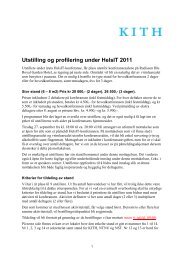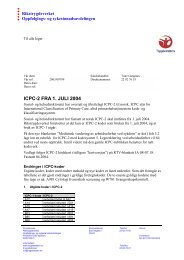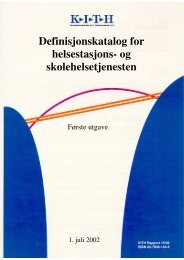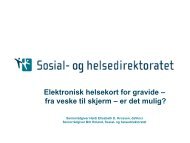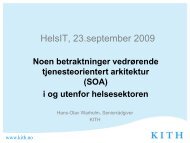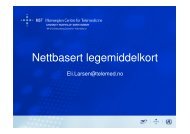ICPC-2e-v.4.2_SQL Technical Guide - KITHs
ICPC-2e-v.4.2_SQL Technical Guide - KITHs
ICPC-2e-v.4.2_SQL Technical Guide - KITHs
You also want an ePaper? Increase the reach of your titles
YUMPU automatically turns print PDFs into web optimized ePapers that Google loves.
(version 4.2.4)<strong>ICPC</strong>-<strong>2e</strong>-<strong>v.4.2</strong>_<strong>SQL</strong> <strong>Technical</strong> <strong>Guide</strong>This document guides you in the use of the distributed <strong>SQL</strong> databaseand the zipped data files.Version 4.2.4Terje Sagen MDThe Norwegian Directorate of HealthPO Box 7000St. Olavs plass0130 OsloNorwayterje.sagen@helsedir.noVersion 4.2.4 This document was updated on May 4. 2012Side 1 of 12
Content1. Introduction ............................................................................................................... 32. <strong>ICPC</strong>-2 structure......................................................................................................... 33. The master database (<strong>SQL</strong>)......................................................................................... 43.1. Changes in structure of version 4.2 ...................................................................... 54. Access database .......................................................................................................... 54.1. Database content ................................................................................................. 55. Data files .................................................................................................................... 55.1. <strong>ICPC</strong>-<strong>2e</strong>-<strong>v.4.2</strong>.4-All_CSV.txt ............................................................................... 65.2. <strong>ICPC</strong>-<strong>2e</strong>-<strong>v.4.2</strong>.4-Title_CSV.txt ............................................................................ 75.3. <strong>ICPC</strong>-<strong>2e</strong>-<strong>v.4.2</strong>.4-Shorttitle_CSV.txt ..................................................................... 75.4. Alphabetical index ............................................................................................... 86. Summary .................................................................................................................... 97. Glossary: ................................................................................................................... 11Date Changes Changed by16. September2007Database changed to new version <strong>ICPC</strong>-<strong>2e</strong>.v.4.0Table and row count not adjusted in this documentDr. SagenKITH AS25.september Filenames are checked Dr. SagenKITH ASUpdated to <strong>ICPC</strong>-<strong>2e</strong>-v.4.0 1WICC meeting in Heidelberg in September 2006.Dr. SagenKITH AS11-15 October,201023.descember2011Annual meeting Ghenthttp://www.ph3c.org/PH3C/docs/27/000113/0000118.pdfUpdategroup finished revisionKees VanBoven27.March 2012 Updated to <strong>ICPC</strong>-<strong>2e</strong>-<strong>v.4.2</strong> (Build420) Dr. Sagen1 For information of the version numbering adapted from 2005 see the document “Version numbering of <strong>ICPC</strong>-2” athttp://www.kith.no/templates/kith_WebPage____1111.aspx2
4.May 2012Updated to <strong>ICPC</strong>-<strong>2e</strong>-<strong>v.4.2</strong> (Build424)Correct all column namesDr. Sagen1. IntroductionKITH AS is since January 1. 2012 incorporated as Department Standardization in TheNorwegian Directorate of Health. The responsibilities for WICC/<strong>ICPC</strong>-2 are continued.The master database and file compilation is done according to WICC meeting in Ghent2010 and Barcelona in 2011.The <strong>ICPC</strong>-<strong>2e</strong>-<strong>v.4.2</strong> was approved by the “WICC Updategroup” February 24th 2012 andby the Chairman April 10th 2012.The master database and output files should be in the following structure or format:ACTION STATUS COMMENTSNormalise the <strong>ICPC</strong> databaseNo constraints on field length (so “shorttext”descriptions of <strong>ICPC</strong> rubrics are no longer necessaryand can be removed)Use semicolon as separator between elementsInclusions separates with semicolonInclusions must be standalone termsExclusions separates with semicolonsExclusions must refer to the original inclusion code textICD-10 separates with semicolonsICD-10 is opened up so that each code is listedseparatelyWICC needs to determine which version of ICD-10will be used in the <strong>ICPC</strong>-ICD map<strong>ICPC</strong>-2 English 2-pager needs to be updatedDoneDoneDoneDoneDoneDoneDoneDoneDoneNo constraintsNot doneWICC update groupDecember 2011The files are correctedaccording to the latestfile WHO 2010 revisedup to 2012. The latestdownloaded file fromWHO is :icd102010enMeta.zip 2Must be done by WI2. <strong>ICPC</strong>-2 structureThe structure of iCPC-2 is described in the <strong>ICPC</strong>-2-R book. The column names in thefiles are according to the book. On the CD the glossary.pdf file describes therequirements under criteria 3 :2 icd102010enMeta.zip downloaded fromhttp://apps.who.int/classifications/apps/icd/ClassificationDownload (The files are dated 20.10.2011codes.txt 11.01.2012)3
criteria The predetermined requirements in a classification for selecting a code. In<strong>ICPC</strong>, these criteria only apply to the coding of diagnoses. <strong>ICPC</strong> has the followingcriteria:1. Inclusion criteria: minimum requirements for coding a specific class;2. Exclusions: list of similar conditions that should be coded elsewhere;3. Inclusions: list of synonyms/alternative descriptions included in that rubric;4. Consider: list of rubrics with their codes, usually less specific, that might beconsidered if the patient’s condition does not meet the inclusion criteria.The column/field names used are:Column name: Column data type: Column description:Code Text A three digit codeComponent Integer Component 1-7Title Text The long title of the codeShortTitle Text The short title of the codeCriteria Text minimum requirements for coding aspecific classInclusions Text list of synonyms/alternative descriptionsincluded in that rubricExclusions Text list of similar conditions that should becoded elsewhereConsider Text list of rubrics with their codes, usuallyless specific, that might be considered ifthe patient’s condition does not meet theinclusion criteriaNote Text Comments about the rubricICD10 Text ICD10 codeICD10Text Text ICD10 text3. The master database (<strong>SQL</strong>)All <strong>ICPC</strong>-2 data is stored in a Microsoft <strong>SQL</strong> Server 2005.3 See definitions under “Glossary” in the end of the document4
The database is normalized and contains tables, views and queries. The output files areproduced from <strong>SQL</strong> scripts. The latest version is version 4.2. In order to keep track ofchanges, the files are marked with a build number3.1. Changes in structure of version 4.23.1.1. InclusionThe inclusion terms are converted to “standalone” terms.Example: ”polyp of stomach ,duodenum, colon, rectum” is rewritten as standaloneterms and separated by ; semicolon to“polyp of stomach”; “polyp of duodenum”; “polyp of colon”; “polyp of rectum”3.1.2. Changes in structure of exclusionThe exclusion terms are converted to “standalone” terms.Example: D77 the text malignancy of stomach, colon/rectum, pancreas D74-76 ischanged to ”malignancy of stomach D74”; “malignancy of colon or rectum D75”;“malignancy of pancreas D76”4. Access databaseThe file <strong>ICPC</strong>-<strong>2e</strong>-v424.mdb is the Access database of the data in <strong>ICPC</strong>-<strong>2e</strong>-<strong>v.4.2</strong>. Thefilename (..v42x) represent the version number in order to track corrections in thedatabase. The last digit is to keep track of the build. ..v424 is the 4 th build and is calledbuild 424. The build number is only for technical purposes and ad there is no change inthe <strong>ICPC</strong> code.The fields are described in chapter 3 and the Access database version described here isjust another data format with the same content as in the flat file <strong>ICPC</strong>-<strong>2e</strong>-<strong>v.4.2</strong>.4-Allfields.txt.The Access database contains only one table with joined data. The file doesnot represent the structure in the master database. Skills in Access are required touse the database. The file is saved in Microsoft Office Access 2003 format.4.1. Database contentThe Access database contains 1 table, 0 views and 0 queries:5. Data filesThe data files are produced as Flat files also called CSV 4 files (comma separated valuesfile format). The file uses semicolon (;) as delimiter and the text is Quoted ”some text”.Semicolon is used because some fields contain commas and will result in problems ifthe tables are read by a parser.4 CSV files can be separated by other delimiter than comma. Commonly comma, Tab and semicolon areused.5
5.1. <strong>ICPC</strong>-<strong>2e</strong>-<strong>v.4.2</strong>.4-All_CSV.txtThe file contains 726 codes with 9 corresponding data fields.Total 10 fieldsRow 1-7 contains metadata and import must start from row 8.Record description:Field name: Field data type: Field data type description:Code Text Length is 3 charactersComponent Integer {1-7} 1 characterTitle Text longest 85 charactersShortTitle Text longest 36 charactersCriteria Text longest 749 charactersInclusions Text longest 383 charactersExclusions Text longest 402 charactersConsider Text longest 217 charactersNote Text longest 1007 charactersICD10 Text longest 2296 characters6
Example from the data file:This record has 9 out of 10 data fields, the Note field is empty:"A74";"7";"Rubella";"Rubella";"an acute exanthem with enlarged lymphnodes, most often suboccipital and post-auricular, with a macular rashon the face, spreading to the trunk and proximal portions of thelimbs; or serological evidence of rubella infection";"complications ofrubella";"roseola infantum A76; congenital rubella A94";"fever A03;other viral exanthem A76; generalized rash S07";"";"B06.0; B06.8;B06.9"5.2. <strong>ICPC</strong>-<strong>2e</strong>-<strong>v.4.2</strong>.4-Title_CSV.txtThe file contains 726 codes with corresponding title and short title.Record description:Field name: Field data type: Field data type description:Code Text Length: 3 charactersTitle Text Length: longest 85 charactersShortTitle Text Length: longest 36 charactersExample from the data file:"B04";"Blood symptom/complaint";"Blood symptom/complaint"5.3. <strong>ICPC</strong>-<strong>2e</strong>-<strong>v.4.2</strong>.4-Shorttitle_CSV.txtThe file contains 726 codes with corresponding short titles.7
Record description:Field name: Field data type: Field data type description:Code Text Length: 3 charactersShortTitle Text Length: longest 36 characters 5Example from the data file:"B04";"Blood symptom/complaint"5.4. Alphabetical indexThe alphabetical index has the same structure as the alphabetical index in the <strong>ICPC</strong>-2-Rbook.The index is not meant to be comprehensive, Nor to be a nomenclature.The alphabetical index contains 2054 lines.The index consists of the following:• Titles of the <strong>ICPC</strong>-2 codes in uppercase• Inclusions of the <strong>ICPC</strong>-2 codes in lowercaseThese comprise the synonyms and terms most commonly used in general familypractice.Users requiring a more extensive index or nomenclature will need to develop their ownor use one that is already available. (Australia, Canada The Netherlands and someScandinavian countries). In order to maintain consistency, this should be done incooperation with the WONCA Classification Committee (WICC)Record description:Field name: Field data type: Field data type description:Text Text longest is 383 characters<strong>ICPC</strong>2_code Text Length is 3 characters5 There is no longer a constraint on field length for ShortTitle8
Example from the data file:"abdominal adhesions";"D99""abdominal colic";"D01""abdominal cramps/discomfort/pain nos";"D01""ABDOMINAL DISTENSION";"D25""ABDOMINAL HERNIA OTHER";"D91"The alphabetical index is distributed with three CSV data files:1. <strong>ICPC</strong>-<strong>2e</strong>-<strong>v.4.2</strong>.4-Alphabetical-index_CSV.txt• sorted by text (Title and Inclusion)2. <strong>ICPC</strong>-<strong>2e</strong>-<strong>v.4.2</strong>-alphabetical-index-inverse-columns.txt• sorted by codes6. SummaryThe <strong>ICPC</strong>-<strong>2e</strong>-<strong>v.4.2</strong> is normalized in an <strong>SQL</strong> database. This is done in order to maintainthe database and make the data consistent. Production of files should only be made fromthe master database.9
The <strong>ICPC</strong>-2 is also updated to <strong>ICPC</strong>-<strong>2e</strong>-<strong>v.4.2</strong> according to the WICC meeting in Ghent(2010), Barcelona (2011) and the work done by the WICC update group in fall 2011The files can be downloaded at the following URL:http://www.kith.no/templates/kith_WebPage____1111.aspxOslo Norway 4. May 2012Terje SagenMDNorwegian Directorate of Health10
7. Glossary 6 :classification system Arrangement of each concept in a domain into classes accordingto established criteria. Prerequisites for a classification are:1. naturalness: the classes correspond to the nature of the thing being classified;2. exhaustiveness: every concept in the domain will fit into a class;3. mutual exclusiveness: a concept included in one rubric cannot be included in another;4. usefulness: the classification is practical;5. simplicity: the subclasses are not excessive.code A fixed sequence of alphabetical and/or numerical characters, designating a concept orterm. In <strong>ICPC</strong>, the codes are alphanumeric. Furthermore, they are significant and mnemonic:they describe the position of the concept in a hierarchy, and are, therefore, easy to remember(<strong>ICPC</strong>-tree).coding system A system that allocates codes to concepts and terms, e.g. reasons for encounter,diagnoses, and interventions, using a finite set of numerical, alphabetical or alphanumericalidentifiers.criteria The predetermined requirements in a classification for selecting a code. In<strong>ICPC</strong>, these criteria only apply to the coding of diagnoses. <strong>ICPC</strong> has the followingcriteria:1. Inclusion criteria: minimum requirements for coding a specific class;2. Exclusions: list of similar conditions that should be coded elsewhere;3. Inclusions: list of synonyms/alternative descriptions included in that rubric;4. Consider: list of rubrics with their codes, usually less specific, that might beconsidered if the patient’s condition does not meet the inclusion criteria.component A part of a larger concept or construction. In the InternationalClassification of Primary Care (<strong>ICPC</strong>), all 17 chapters (except chapter Z: Socialproblems) contain 7 identical components:1: symptom and complaint component;2: diagnostic, screening, and prevention component;3: medication, treatment, procedures component;4: test results component;5: administrative component;6: referrals and other reasons for encounter component;7: disease component.Chapter Z has no 7th component.consider See: criteria.6 From <strong>ICPC</strong>-2-R companion CD11
exclusions See: criteria.inclusions See: criteria.NOS Not Otherwise Specified: the term to be coded cannot be classified to a more specificrubric.rubric Text string that describes a class in a coding system/terminology.term A word or group of words, which labels a concept in a defined way. The word forthe concept and the term are often the same. Terms are narrower than the conceptbehind them. Terms can be defined differently in different professional domains,disciplines, or specialities if they serve different clinical utilities. In primary care, a termis concerned with broader concepts than in more specialized disciplines, because of theclinical utility.terminology List of terms referring to the concepts in a particular domain.WICC Wonca International Classification Committee, a standing committee of Wonca,dealing with classification and tools that are useful for performing research ingeneral/family practice, e.g. <strong>ICPC</strong> and the Wonca Dictionary of General/Family Practice.The committee is the longest standing committee of Wonca. Its most extensive work hasbeen the development of classifications for primary care: ICHPPC, IC-Process-PC, and<strong>ICPC</strong>; the latter is the most comprehensive.See: http://www.globalfamilydoctor.com/WICCWonca World Organization of Family Doctors. See: http://www.globalfamilydoctor.comWHO World Health Organization. See: http://www.who.int/about12


